Today we’re going to head out to one of my favorite hunting grounds for cheap high-yield stocks: the midcap space.
“Wait,” you may be thinking. “Haven’t midcap stocks been on a tear? How can there be any bargains left?”
You’d be right about the first part … but not the second.
To get at why, let’s look at how the benchmark S&P MidCap 400 ETF (MDY) has performed vs. its large-cap cousin, the SPDR S&P 500 ETF (SPY) in the past year:
Midcaps Soar…
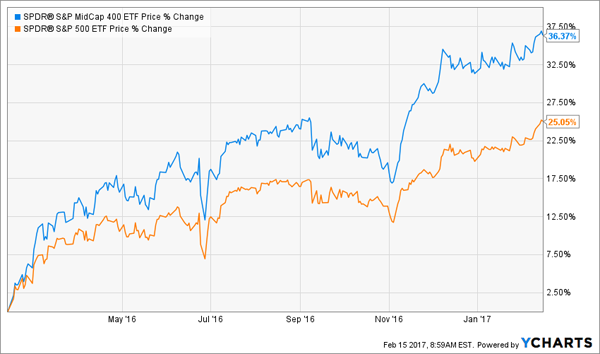
That rise has had a predictable effect on both funds’ dividend yields (because you calculate yield by dividing the annual dividend into the current share price):
…While Yields Shrink

I know—this still doesn’t make midcaps look like an ideal spot to find bargain high-yielders, but hear me out.
Because with all the attention going to large caps and, to a lesser degree, high-growth small caps, midcaps are the market’s version of “flyover country”: you may have heard of them, but probably not in much depth, because the big players suck up all the oxygen.
Take Old Republic International (ORI), a 3.6% yielder with a $5.4-billion market cap I’ll say more about below. As I write, just 2 analysts cover the insurer. That’s enough to fit on a motorcycle!
Compare that to JPMorgan Chase & Co. (JPM), a giant in the financial-services space, with a market cap of $328.2 billion and the attention of 28 analysts.
That research gap—plus the fact that midcaps make up a big slice of all publicly traded companies (some 24% of their total market cap)—gives us a terrific chance to grab tomorrow’s JPM today … and pocket a nice payout while we wait.
I’ll get to my 5 midcap high-yielders that should be on your radar now (and rank them in order of quality) in just a moment. First I want to show you…
How I Found My 5 “Goldilocks” Dividend Contenders
To zero in on the best midcaps for income, I pulled the top yielders in the S&P 500 Midcap Index and ran them through a rigorous test.
To make the cut, they needed a dividend yield of at least 3%, (ideally higher, but I’ll settle for 3% if they can keep me interested with dividend growth); a reasonable payout ratio (or the percentage of earnings paid out as dividends); a history of earnings growth; and a reasonable price-to-earnings (P/E) ratio.
I also excluded real estate investment trusts (REITs), because we’ve covered them in recent ContrarianOutlook.com articles you can access by clicking here and here.
Here are my five finalists.
The Shortlist
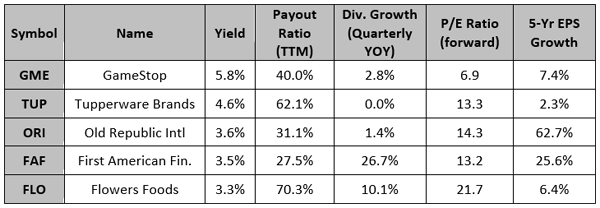
Now let’s take a deeper dive and rank them, starting with…
Midcap Pick No. 5: Tupperware Brands
Tupperware Brands (TUP) is the second-highest yielder on my list, at 4.6%. Its payout ratio is going the right way, too, as earnings head upward:
Dividend Stability Improves
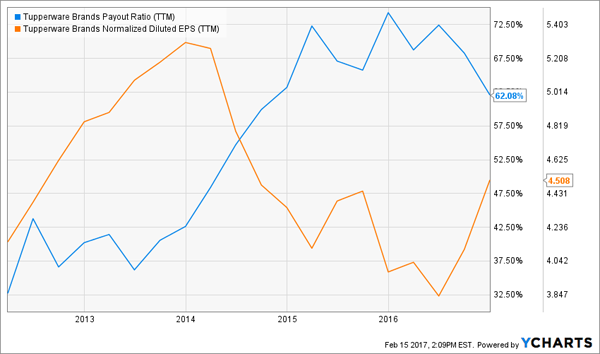
So why is TUP only in fifth spot? For one, even though it’s headed the right way, at 62%, its payout ratio is still a touch above the 50% I like to see in a stock. The dividend also hasn’t risen since April 2014 (when management hiked it by 9.6%), and back then, the payout ratio was 42.6%. If TUP waits to get to that level again, the next increase could still be a ways off.
Then there’s the emerging-market exposure (65% of fourth-quarter sales). This will benefit TUP in the long run, as these countries’ middle classes grow. But in the near term, the high greenback is weighing on TUP’s already-slow growth: management expects 2017 sales to be flat to up 2% this year in US dollars (or 1% to 3% in local currency).
Midcap Pick No. 4: Old Republic International
Old Republic International (ORI) offers commercial, residential and title insurance. Like all insurers, it will benefit as interest rates rise, because it invests the premiums it collects in interest-bearing securities.
The problem? ORI is one midcap that’s gotten the herd’s attention: the stock has surged 24.5% since Election Day and now trades at 14.3 times forecast earnings.
That may sound reasonable, but its well above ORI’s five-year average of 13.5 and the forward P/E on one of my favorite large-cap insurers, Prudential Financial (PRU), which boasts a comparable 3.3% dividend yield and much faster dividend growth.
No Midcap Edge for ORI
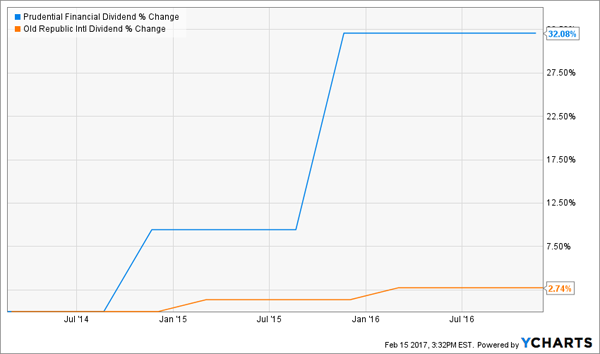
The bottom line here is that I’d rather buy PRU than ORI at these levels. But I’d much rather buy my No. 1 midcap pick (which is also an insurer) than either of these two. More on that below.
First, let’s move on to…
Midcap Pick No. 3: Flowers Foods
Flowers Foods (FLO) is the priciest of all our picks, with a forward P/E ratio of 21.7. But of course, comparing the baked-goods maker to stocks in different industries doesn’t tell us much; we’re better off stacking it up next to its peers.
And here, it stacks up pretty well, trading above General Mills (GIS), at 20.0 but below ConAgra Brands (CAG), at 23.5.
However, FLO easily beats both on the yield and dividend-growth front. It’s also made some smart moves in the fresh-food space, with its acquisitions of Alpine Valley Bread and Dave’s Killer Bread last year.
But costs related to its growth plan will weigh on its earnings this year: for all of 2017, Flowers expects EPS of $0.85 to $0.95, compared to $0.91 in 2016. Add in a 70% payout ratio, and I don’t expect much near-term growth from this payout—which makes the 3.3% yield somewhat less tasty—though it is safe.
MidCap Pick No. 2: GameStop
GameStop (GME) boasts a forward P/E ratio of just 6.9 and a 5.8% dividend yield.
The videogame purveyor is in the doghouse for poor Christmas sales (down 18.7% from 2015) and the fact that more gamers are getting their fix online than through the store-bought games GME peddles through its 7,000+ outlets.
However, the weak Christmas sales were due in part to a weak slate of games from the likes of Electronic Arts (EA) and Activision (ATVI). And management’s deftly navigating the shift, shuttering underperforming stores and shifting toward things like digital games and collectibles. These products supplied 22% of revenue in the latest quarter, up from 15% a year ago.
GME has time to get its revival right: its balance sheet is healthy and its free cash flow easily covers the dividend, leaving plenty of room for more hikes.
A Dividend Whiz
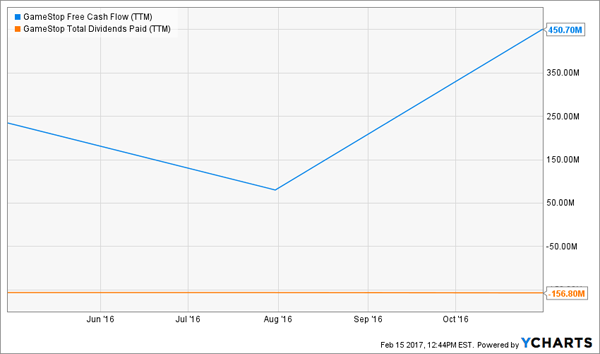
Which brings me to…
Midcap Pick No. 1: First American Financial
First American Financial (FAF): I hope you bought my top pick when I recommended it on January 9. If so, you’re up nearly 4% in just five weeks and you’re likely in line for a nice dividend hike in May, after the title insurer rolled out a big raise last May. The low 27.5% payout ratio should see to that.
If haven’t gotten in, you can still buy at a reasonable 13.6 times forward earnings, and the dividend yield still sits at 3.5%. That’s enticing given FAF’s payout growth:
Dividend Growth Booms
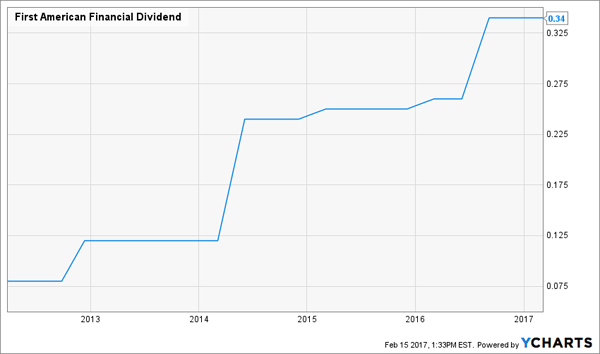
FAF is essentially a bet on the housing market, and it’s a bet I’ll happily take: home resales slipped 2.8% in December, but that’s because there was nothing to buy! Inventory is at lows not seen in 18 years, but rising prices should encourage sellers to get off the fence. Meanwhile, strong job growth will help keep buyers in the game.
6 “No-Brainer” Buys to Double Your Income
These 5 midcap plays have a lot going for them, but there’s a problem: between them, they throw off just a 4.2% dividend yield.
Sure, that’s a lot better than the 2.0% you get from the average S&P 500 stock, but it’s still not going to cut it on the income front—especially if you’re in or near retirement.
That’s where the 6 income powerhouses in our new “No-Withdrawal” retirement portfolio come in. They throw off rock-solid yields of 6%, 8%, 9% and up.
And with an average payout of 8%, this portfolio will easily hand you $40,000 in income for every $500,000 you invest!
Like all 5 of our midcap plays, these dividend stars are off the herd’s radar, so they’re cheap now, but that won’t last. Don’t miss out. Click here and I’ll share our 6 top picks for 8% income and double-digit upside.
